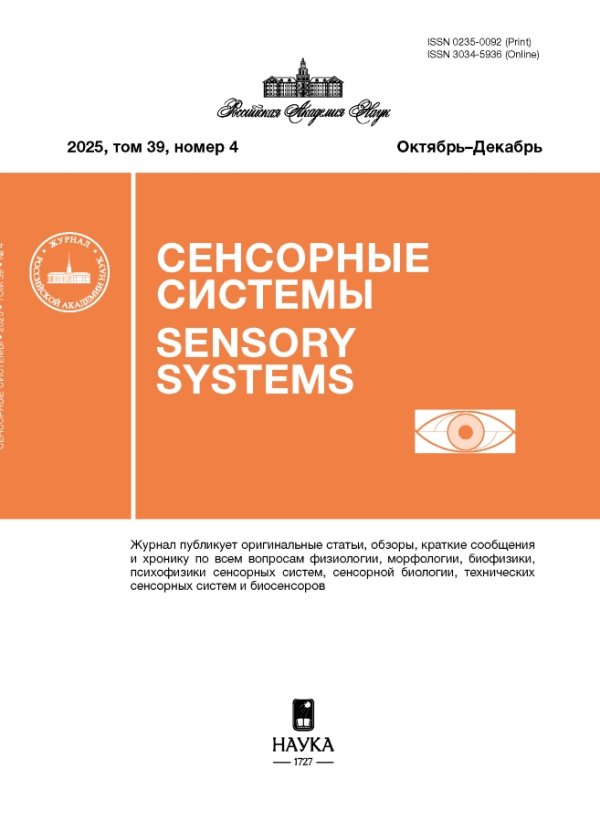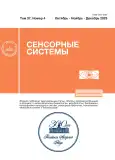Development of methodological approaches to assess the functional state of the inner ear labyrinth
- Authors: Toropchina L.V.1
-
Affiliations:
- FBSEI APE Russian Medical Academy of Continuous Professional Education of the Ministry of Healthcare of Russia
- Issue: Vol 37, No 4 (2023)
- Pages: 330-341
- Section: ОБЗОРЫ
- URL: https://journals.rcsi.science/0235-0092/article/view/229413
- DOI: https://doi.org/10.31857/S023500922304008X
- EDN: https://elibrary.ru/QZEBIS
- ID: 229413
Cite item
Full Text
Abstract
Modeling the propagation of sound vibrations from the foot plate of the stirrup in the oval window to the perceiving formations of the organ of Corti is a difficult experimental problem. In the search for the causes of hearing loss, tone threshold audiometry has traditionally been considered as the basis of diagnosis. The presence of an air-bone gap on an audiogram was associated with a dysfunction of the middle ear; however, in many cases, an air-bone gap is detected when the pathology is localized in the structures of the inner ear. The review shows that pathological conditions that impair intracochlear sound conduction are successfully detected using computed tomography of the temporal bones. The classification of pathological conditions of the labyrinth, giving the bone-air gap on the tone threshold audiogram, was performed.
About the authors
L. V. Toropchina
FBSEI APE Russian Medical Academy of Continuous Professional Education of the Ministry of Healthcare of Russia
Author for correspondence.
Email: liyatoropchina@yandex.ru
Russia,
125993, Moscow, st. Barrikadnaya, 2/1, building 1
References
- Voyachek V.I. Izbrannye voprosy voennoj otolaringologii [Selected issues of military otolaryngology]. Leningrad. Ed. VMA RKKA, 1934.202 p. (in Russian).
- Voyachek V.I. Osnovy oto-rino-laringologii [Fundamentals of oto-rhino-laryngology]. Medgiz, Leningrad branch, 1953. 348 p. (in Russian).
- Kapustina T.A. Special’naja klassifikacija smeshannyh form narushenij sluha dlja vybora taktiki lechenija [Special classification of mixed forms of hearing impairment for the choice of treatment tactics]. Baikal Medical Journal. 1999. No. 1. T. 16. P. 25–28 (in Russian).
- Kulikovsky G.G. K voprosu o fiziologii kostnoj provodimosti v svjazi s vibracionnoj chuvstvitel’nost’ju i ee znachenie v shumovoj profvrednosti (klinicheskoe i jeksperimental’noe issledovanie) [On the question of the physiology of bone conduction in connection with vibration sensitivity and its significance in noise occupational hazard (clinical and experimental study)]. Voprosy medicinskogo obespechenija aviacii. Sbornik trudov. Tom 1. Izbrannye voprosy fiziologii organa zrenija i LOR organov [Issues of medical support for aviation. Collection of works. Volume 1. Selected questions of the physiology of the organ of vision and ENT organs]. M., State Military Publishing House of the People’s Commissariat for Defense of the USSR, 1939. 232 p. (in Russian).
- Sagalovich B.M. Obshhaja semiotika tugouhosti [General semiotics of hearing loss]. Tugouhost’. Pod red. Preobrazhenskogo N.A. [Hearing loss. Ed. Preobrazhensky N.A.]. M.: Medicine, 1978. 440 p. (in Russian).
- Sagalovich B.M., Palchun V.T. Bolezn’ Men’era [Meniere’s disease]. M.: Medical Information Agency, 1999. 524 p. (in Russian).
- Temkin Ya.S., Likhachev A.G., Preobrazhensky B.S. Bolezni uha, gorla i nosa [Diseases of the ear, throat and nose]. M.: Medgiz, 1947. 374 p. (in Russian).
- Undrits V.F. O bolezni Men’era [About Meniere’s disease]. Vestnik Oto-Rino-Laringologii [Bulletin of Otorhinolaryngology]. 1958. No. 6. Р. 57–65 (in Russian).
- Khrappo N.S. Issledovanie vestibuljarnoj funkcii [Study of vestibular function]. Rukovodstvo po otorinolaringologii. Pod red. I.B. Soldatova. 2-e izd. [Guide to otorhinolaryngology. Ed. I.B. Soldatov. 2nd ed.]. M.: Medicine. 1997. P. 62–84 (in Russian).
- Balili I., Sullivan S., Mckeever P., Barkan A. Pituitary carcinoma with endolymphatic sac metastasis. Pituitary. 2014. V. 17 (3). P. 210–213. https://doi.org/10.1007/s11102-013-0489-x
- Bance M. When is a conductive hearing loss not a conductive hearing loss? Causes of a mismatch in air-bone threshold measurements or a “pseudoconductive” hearing loss. J. Otolaryngol. 2004. V. 33 (2). P. 135–138. https://doi.org/10.2310/7070.2004.00135
- Benson J.C., Diehn F., Passe T., Guerin J., Silvera V.M., Carlson M.L., Lane J. The Forgotten Second Window: A Pictorial Review of Round Window Pathologies. AJNR Am J Neuroradiol. 2020.V. 41 (2). P. 192–199. https://doi.org/10.3174/ajnr.A6356
- Berretrini S., Forli F., Bogazzi F., Neri E., Salvatori L., Casani A.P., Franceschinni S.S. Large vestibular aqueduct syndrome: audiological, radiological, clinical, and genetic features. Am J Otolaryngol. 2005. V. 26 (6). P. 363–371. https://doi.org/10.1016/j.amjoto.2005.02.013
- Bertholon P., Karkas A. Otologic disorders causing dizziness, including surgery for vestibular disorders. Handbook of Clinical Neurology, 2016. V. 137. P. 279–293. https://doi.org/10.1016/B978-0-444-63437-5.00020-0
- Bezold F., Siebenmann F. Text-book of Otology for Physichian and Students in 32 Lectures, translated by J. Holinger, M.D. Chicago. Colegrove, 1908. 349 p.
- Castellucci A., Brandolini C., Modugno G.C. Tympanometric findings in superior semicircular canal degiscence syndrome. Acta Otorhinolaryngol Ital. 2013. V. 33 (2). P. 112–120.
- Coles P. External meatus closure by audiometer earphones. Journal of Speech and Hearing Disorders. 1967. V. 32. P. 296–297.
- Deep N.L., Kay-Rivest E., Jr J. T.R. Iatrogenic Third Window After Retrosigmoid Approach to a Vestibular Schwannoma Managed with Cochlear Implantation. Otol Neurotol. 2021. V. 42 (9). P. 1355–1359. https://doi.org/10.1097/MAO.0000000000003267
- Gadre A.K., Edwards I.R., Baker V.M., Roof C.R. Membranous or Hypermobile Stapes Footplate: A New Anatomic Site Resulting in Third Window Syndrome. Front Neurol. 2020. V. 11. Art. 871. https://doi.org/10.3389/fneur.2020.00871
- Gioacchini F.M., Kaleci S., Chiarella G., Viola P., Pisani D., Scarpa A., Tulli M., Pace A., Iannella G., Re M. Symptoms and clinical features in patients affected by endolymphatic sac tumor: a systematic review and meta-analysis. Eur Arch Otorhinolaryngol. 2022. V. 279 (11). P. 5081–5088. https://doi.org/10.1007/s00405-022-07469-6
- Glasscock M., Shambaugh G., Johnson D. Surgery of the Ear. Philadelphia. Saunders, 1990. 656 p.
- Guan X., Cheng Y.S., Galaiya D.J., Rosowski J.J., Lee D.J., Nakajima H.H. Bone-conduction hyperacusis induced by superior canal dehiscence in human: the underlying mechanism. Sci Rep. 2020. V. 10 (1). P. 16564. https://doi.org/10.1038/s41598-020-73565-4
- Jackler R.K., Hwang P.H. Enlargement of the cochlear aqueduct: fact or fiction? Otolaryngol Head Neck Surg. 1993. V. 109 (1). P. 14–25. https://doi.org/10.1177/019459989310900104
- Kim H.H.S., Wilson D.F. A third mobile window at the cochlear apex. Otolaryngol Head Neck Surg. 2006. V. 135 (6). P. 965–966. https://doi.org/10.1016/j.otohns.2005.04.006
- Margolis R.H., Eikelboom R.H., Johnson C., Ginter S.M., Swanepoel De W., Moore B.C.J. False air-bone gaps at 4 kHz in listeners with normal hearing and sensorineural hearing loss. Int. J. Audiol. 2013.V. 52 (8). P. 526–532. https://doi.org/10.3109/14992027.2013.792437
- Martin С., Tringali S., Bertholon P., Pouget J.-F., Prades J.-M. Isolated congenital round window absence. Ann Otol Rhinol Laryngol. 2002. V. 111 (9). P.799–801. https://doi.org/10.1177/000348940211100907
- Merchant S.N., Nakajima H.H., Halpin C., Nadol J.B. Jr, Lee D.J, Innis W.P, Curtin H., Rosowski J.J. Clinical investigation and mechanism of air-bone gaps in large vestibular aqueduct syndrome. Ann Otol Rhinol Laryngol. 2007. V. 116 (7). P. 532–541. https://doi.org/10.1177/000348940711600709
- Merchant S.N., Rosowski J.J. Conductive hearing loss caused by third-window lesions of the inner ear. Otol. Neurotol. 2008. V. 29 (3). P. 282–289. https://doi.org/10.1097/mao.0b013e318161ab24
- Mikulec A.A., McKenna M.J., Ramsey M.J., Rosowski J.J., Herrmann B.S., Rauch S.D., Curtin H.D., Merchant S.N. Superior semicircular canal dehiscence presenting as conductive hearing loss without vertigo. Otol. Neurotol. 2004. V. 25 (2). P. 121–129. https://doi.org/10.1097/00129492-200403000-00007
- Minor LB. Superior canal dehiscence syndrome. Am. J. Otol. 2000. V. 21. P. 9–19.
- Monsell E.M. The mechanism of hearing loss in Paget’s disease of bone. Laryngoscope. 2004. V. 114 (4). P. 598–606. https://doi.org/10.1097/00005537-200404000-00002
- Neyt P., Govaere F., Forton G.E.J. Simultaneous true stapes fixation and bilateral bony dehiscence between the internal carotid artery and the apex of the cochlea: the ultimate pitfall. Otol. Neurotol. 2011. V. 32 (6). P. 909–913. https://doi.org/10.1097/MAO.0b013e318225573f
- Nober E.H. Vibrotactile sensitivity of deaf children to high intensity sound. Laryngoscope. 1967. V. 77 (12). P. 2128–2146. https://doi.org/10.1288/00005537-196712000-00005
- Nober E.H. Cutile air and bone conduction thresholds of the deaf. Exceptional Child. 1970. V. 36 (8). P. 571–579.
- Parving A., Bak-Pedersen K. Clinical findings and diagnostic problems in sensorineural low frequency hearing loss. Acta Otolaryngol. 1978. V. 85 (3–4). P. 184–190. https://doi.org/10.3109/00016487809111925
- Pogodzinski M.S., Shallop J.K., Sprung J., Weingarten T.N., Wong G.Y., McDonald T.J. Hearing loss and cerebrospinal fluid pressure: case report and review of the literature. Ear. Nose. Throat J. 2008. V. 87 (3). P. 144–147.
- Pogson J.M., Taylor R.L., Thompson E.O., Magnussen J.S., Welgampola M.S., Halmagyi G.M. A Window Into the Whole Story: Temporal Bone Plasmacytoma Presenting With a Mobile Third Window. Laryngoscope. 2021. V. 131 (3). E966–969. https://doi.org/10.1002/lary.28951
- Politzer A. Geschichte der Ohrenheilkunde. Zwei Band. Von 1850–1911. Verlag von Ferdinand Enke. Stuttgart, 1913. 570 p.
- Reda J.D., West N., Cayé-Thomasen P. Intracochlear Vestibular Schwannoma Presenting with Mixed Hearing Loss. J. Int. Adv. Otol. 2021. V. 17 (3). P. 265–268. https://doi.org/10.5152/iao.2021.8586
- Reynard P., Idriss S., Ltaief-Boudrigua A., Bertholon P., Pirvan A., Truy E., Thai-Van H., Ionescu E.C. Proposal for a Unitary Anatomo-Clinical and Radiological Classification of Third Mobile Window Abnormalities. Front Neurol. 2022. V. 12. Art. 792545. https://doi.org/10.3389/fneur.2021.792545
- Rinne F.H.A. Beiträge zur Physiologie des menschlichen Ohres. Vierteljahrsschrift für die praktische Heilkunde. Prague.1855. V. 45. P. 71–123.
- Ross M., Tucker C.A. A case study of collapse of the ear canal during audiometry. Laryngoscope. 1965. V. 75. P. 65–67. https://doi.org/10.1288/00005537-196501000-00008
- Rudmin F. False air-bone gap. Ear Hear. 1983. V. 4 (2). P. 106–107. https://doi.org/10.1097/00003446-198303000-00009
- Snik A.F., Hombergen G.C., Mylanus E.A., Cremers C.W. Air-bone gap in patients with X-linked stapes gusher syndrome. Am. J. Otol. 1995. V. 16 (2). P. 241–246.
- Tonndorf J. Sensorineural and pseudosensorineural hearing losses. ORL J Otorhinolaryngol Relat Spec. 1988. V. 50 (2). P. 79–83. https://doi.org/10.1159/000275974
- Valsalva A.M. De aure humana tractatus. Bononie, 1704. 228 p.
- Wackym P.A., Balaban C.D., Zhang P., Siker D. A., Hundal J.S. Third Window Syndrome: Surgical Management of Cochlea-Facial Nerve Dehiscence. Front Neurol. 2019. V. 10. Art. 1281. https://doi.org/10.3389/fneur.2019.01281
- Wong W.K., Salkeld L., Flint D. Isolated Congenital Round Window Atresia: Report of 2 Cases. Ear Nose Throat J. 2020. V. 99 (7). P. 433–436. https://doi.org/10.1177/0145561319840541
- Zhou G., Gopen Q., Kenna M.A. Delineating the hearing loss in children with enlarged vestibular aqueduct. Laryngoscope. 2008. V. 118 (11). P. 2062–2066. https://doi.org/10.1097/MLG.0b013e31818208ad
Supplementary files













